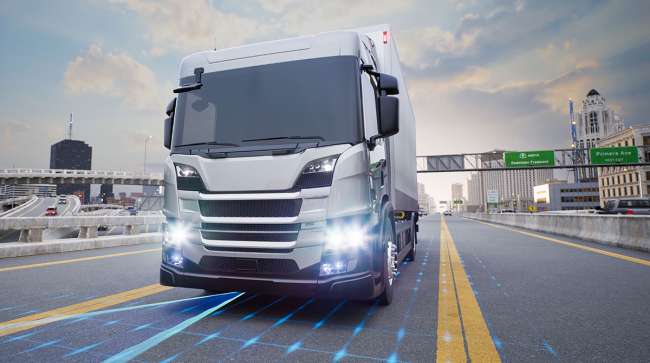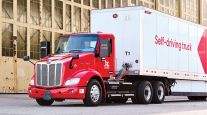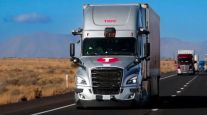Staff Reporter
Kentucky Lawmakers Override Veto, OK Fully Autonomous Vehicles

[Stay on top of transportation news: Get TTNews in your inbox.]
Kentucky has legally paved the way for autonomous vehicles on its roadways with the legislators gathering enough support April 12 to overcome significant opposition in both chambers to override Gov. Andy Beshear’s veto of House Bill 7.
Beshear on April 5 vetoed the legislation that he described as broadly written to OK fully autonomous vehicles, including commercial vehicles, on Kentucky roads and highways.
“Opening Kentucky’s highways and roads to fully autonomous vehicles should occur only after careful study and consideration and an extensive testing period with a licensed human being behind the wheel, which is what other states have done before passing such laws,” the governor stated.
He noted that the bill failed to “fully address questions about the safety and security of autonomous vehicles, nor does it implement a testing period that would require a licensed human driver to be behind the wheel.”

Beshear
The legislation (HB 7, An Act Relating to Autonomous Vehicles) created sweeping and lengthy revisions to state statute “Chapter 186: Licensing of Motor Vehicles, Operators and Trailers” that ultimately added nine new sections and changed four other parts to span a total of 34 pages.
The final law went through various iterations as it was subject to a series of successful, withdrawn and failed amendments proposed by lawmakers after it was introduced Jan. 9 in the state House. Its sponsors in the House were all Republications: Reps. Josh Bray, David Meade, Steve Bratcher and Killian Timoney.
House lawmakers overcame the governor’s veto on a 58-40 vote, but the Senate posed more hurdles before a 21-15 passage.

Taylor
Rick Taylor, president and CEO of Kentucky Trucking Association, said KTA supported the measure without testifying in favor or lobbying for it to succeed. This last legislative session, which adjourned April 15, was the second time a bill for autonomous vehicles had been debated.
Taylor told Transport Topics that KTA favored the new law because Kentucky needs to be in a position to participate in the autonomous vehicle movement when it becomes a way to complement normal trucking, especially considering the state’s manufacturing strengths in the heavy automotive and aerospace industries. According to the state Cabinet for Economic Development, Kentucky exported nearly $10.5 billion in aerospace products/parts in 2022 and boasts more than 100 aerospace-related facilities employing over 23,000 workers.
He said KTA supported the legislation to put Kentucky in a position to adopt autonomous vehicles when the technology enters “the industry space in some form or fashion here.”
Volvo's Chayene de Souza and Magnus Gustafson discuss how new, connected trucks can boost business, enhance safety practices, and reinforce preventative maintenance plans. Tune in above or by going to RoadSigns.ttnews.com.
Text of the new law emphasizes that nothing in it prohibits or restricts a human driver from operating a fully autonomous vehicle equipped with controls enabling the human driver to control all or part of the dynamic driving task. It also defines a motor carrier vehicle to include a fully autonomous used by a motor carrier to transport passengers or property.
Most of the new law takes effect June 15, according to a Kentucky legislative spokesman.
From the law’s effective date until July 31, 2026, a fully autonomous vehicle having a declared gross vehicle weight and any towed unit weighing more than 62,000 pounds must have a human driver with appropriate credentials to operate the vehicle, be inside it to monitor performance and intervene if needed. This requirement is not defined as a testing period. Only the lead vehicle in a truck platoon must have a human driver behind the wheel until Aug. 1, 2026, when the human driver need is eliminated.
Having specific amounts of insurance for autonomous vehicles also is specified. Any fully autonomous vehicle operating under the new law must have on file with the department indemnifying bonds or insurance policies of at least $1 million of total liability for death of/injury to persons resulting from an accident as well as $1 million worth of coverage for property damage. Also, if an accident involves a fully autonomous vehicle, that vehicle’s owner/designate is responsible for filing an accident report with law enforcement.
Want more news? Listen to today's daily briefing above or go here for more info
Proof of the insurance requirements must be filed with the Kentucky Transportation Cabinet before a fully autonomous vehicle can operate on a state highway without a human driver.
Many of the new sections of state law contain regulations about the operational and performance standards of fully autonomous vehicles and automated driving systems.
The legislation also prohibits public agencies from banning the operation of fully autonomous vehicles or automated driving systems or imposing any restrictive rules to differentiate how these types of vehicles/systems are treated compared with traditional vehicles. Only the Transportation Cabinet will administer laws and regulations for fully autonomous vehicles.
It also prevents state agencies from passing rules/ordinances to impose taxes, fees or other requirements, including performance standards, targeted to the use of fully autonomous vehicles and automated driving systems.
First Things First
Before operating a fully autonomous vehicle on state highways without a human driver, a person shall submit a law enforcement interaction plan to the Transportation Cabinet and the Kentucky State Police that describes how to:
• Communicate with a fleet support specialist who is available when the fully autonomous vehicle is in use
• Safely remove the fully autonomous vehicle from the roadway and tow it
• Recognize when an automated driving system is engaged on a fully autonomous vehicle
• Any additional information a manufacturer or owner determines is necessary regarding hazardous conditions or public safety risks associated with operating a fully autonomous vehicle





